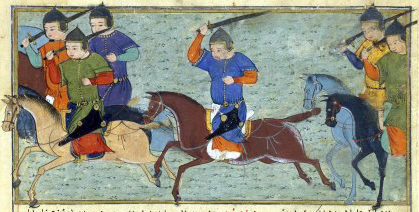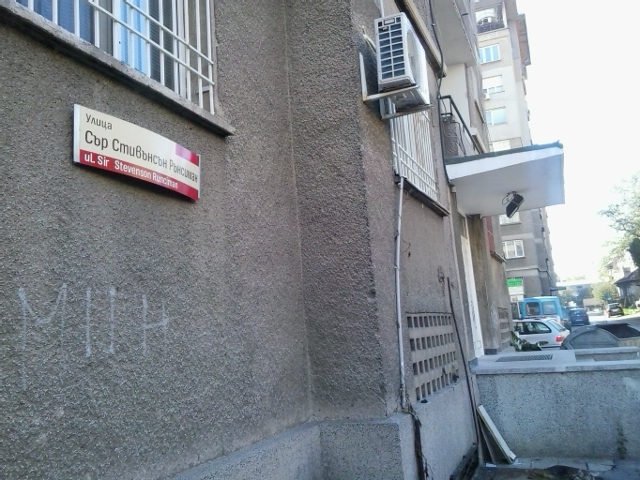|
Abagha
Abaqa Khan (27 February 1234 – 4 April 1282, mn, Абаха/Абага хан (Khalkha Cyrillic), ( Traditional script), "paternal uncle", also transliterated Abaġa), was the second Mongol ruler (''Ilkhan'') of the Ilkhanate. The son of Hulagu Khan and Lady Yesünčin and the grandson of Tolui, he reigned from 1265 to 1282 and was succeeded by his brother Ahmed Tekuder. Much of Abaqa's reign was consumed with civil wars in the Mongol Empire, such as those between the Ilkhanate and the northern khanate of the Golden Horde. Abaqa also engaged in unsuccessful attempts at invading Syria, which included the Second Battle of Homs. Life Abaqa was born in Mongolia on 27 February 1234, son of Ilkhanate founder Hulagu Khan. Abaqa was a Buddhist. A favoured son of Hulagu, he was made governor of Turkestan.Runciman, p. 320. Hulagu died from illness in 1265. Before his death, he had been negotiating with the Byzantine Emperor Michael VIII Palaiologos to add a daughter of the Byzantine i ... [...More Info...] [...Related Items...] OR: [Wikipedia] [Google] [Baidu] |
Golden Horde
The Golden Horde, self-designated as Ulug Ulus, 'Great State' in Turkic, was originally a Mongols, Mongol and later Turkicized khanate established in the 13th century and originating as the northwestern sector of the Mongol Empire. With the fragmentation of the Mongol Empire after 1259 it became a functionally separate khanate. It is also known as the Kipchak Khanate or as the Ulus of Jochi, and replaced the earlier less organized Cuman–Kipchak confederation. After the death of Batu Khan (the founder of the Golden Horde) in 1255, his dynasty flourished for a full century, until 1359, though the intrigues of Nogai Khan, Nogai instigated a partial civil war in the late 1290s. The Horde's military power peaked during the reign of Uzbeg Khan (1312–1341), who adopted Islam. The territory of the Golden Horde at its peak extended from Siberia and Central Asia to parts of Eastern Europe from the Ural Mountains, Urals to the Danube in the west, and from the Black Sea to the Caspian ... [...More Info...] [...Related Items...] OR: [Wikipedia] [Google] [Baidu] |
Borjigin
A Borjigin, ; ; russian: Борджигин, Bordžigin; English plural: Borjigins or Borjigid (from Middle Mongolian);''Histoire des campagnes de Gengis Khan'', p. 119. Manchu plural: is a member of the Mongol sub-clan, which started with Bodonchar Munkhag of the Kiyat clan. Yesugei's descendants were thus said to be Kiyat-Borjigin. The senior Borjigids provided ruling princes for Mongolia and Inner Mongolia until the 20th century.Humphrey & Sneath, p. 27. The clan formed the ruling class among the Mongols and some other peoples of Central Asia and Eastern Europe. Today, the Borjigid are found in most of Mongolia, Inner Mongolia and Xinjiang, and additionally genetic research has shown that descent from Genghis Khan and Amir Timur Barlas is common throughout Central Asia and other regions. Origin and name The patrilineage began with Blue-grey Wolf (Börte Chino) and Fallow Doe (Gua Maral). According to ''The Secret History of the Mongols'', their 11th generation descend ... [...More Info...] [...Related Items...] OR: [Wikipedia] [Google] [Baidu] |
El Qutlugh Khatun
El Qutlugh Khatun (; ) was the daughter of Abaqa Khan (r. 1265–82), the second Mongol ruler of the Ilkhanate. Her story, included in Khalīl ibn Aybeg al-Ṣafadī's (around 1297-1363) bibliographic dictionary, sheds light on changing gender norms during the widespread conversion in the Ilkhanate to Islam. Her story also depicts the status of women during the period. The Hajj It is unclear how many women went on the Hajj during the pre-modern era. According to al-Ṣafadī', however, El Qutlugh was one of the women who did make the journey. Her travels were done on horseback (not in a palanquin fastened to a camel) with a quiver of arrows at her waist. There were differences in her journey in comparison to the wives of senior Mamluk officials from the same period. Her hajj trip happened in 1323. Family She was married to Ghurbatai Güregen from the Hushin tribe. Her husband was active during Arghun and Gaykhatu's reign, supported the latter during Baydu's revolt. He also had ... [...More Info...] [...Related Items...] OR: [Wikipedia] [Google] [Baidu] |
Ilkhan (title)
Il Khan (also ''il-khan'', ''ilkhan'', ''elkhan'', etc.), in Turkic languages and Mongolian, is a title of leadership. It combines the title ''khan'' with the prefix ''el/il'', from the word ''ulus'' – 'tribe, clan', 'the people', 'nation', 'homeland', 'state', 'tribal union', etc. Meaning The exact meaning depends on context: *Khan of the nation. The earliest mention of a similar title in this meaning, namely "Illig Qaghan", refers to Bumin Qaghan and dates to 552 CE. (In fact, Nikolai Gumilyov transcribes Bumin's title as "ilkhan".) *More recently, the tribal chief that heads both branches of the Bakhtiari people, under whom several ''khans'' operate (20th century CE). In the context of the Hulaguid dynasty, commonly known as the Ilkhanate, the title ''Ilkhan'' was borne by the descendants of Hulagu and later other Borjigin princes in Persia, starting from c. 1259-1265. Two interpretations have been proposed: *'submissive', 'peaceable', 'obedient', or 'subservient' khan, or ... [...More Info...] [...Related Items...] OR: [Wikipedia] [Google] [Baidu] |
Ahmed Tekuder
Ahmed Tekuder ( Mongolian: ''Tegülder'', meaning “perfect”; fa, تکودر) (c.1246 10 August 1284), also known as Sultan Ahmad (reigned 1282–1284), was the sultan of the Persian-based Ilkhanate, son of Hulegu and brother of Abaqa. He was eventually succeeded by his nephew Arghun Khan. Early life Tekuder was born c. 1246 in Mongolia to Hulagu and Qutui Khatun from Khongirad tribe as his seventh son. His birth date is not mentioned elsewhere but according to sources he died at age of 37, therefore his birth year must have been around 1246 or 1247. He was baptized in his childhood as a Nestorian Christian and was given name ''Nicholas''. He arrived in the Ilkhanate sometime in 1260s with his mother Qutui and brother Tekshin. Years later, he was granted governorship of Nahavand and Dinavar by Abaqa, who respected his mother Qutui. Qutui was also invested with territories with income of 100.000 gold coins near Mayyafariqin by Abaqa. Conversion to Islam The circumstances of ... [...More Info...] [...Related Items...] OR: [Wikipedia] [Google] [Baidu] |
Silver Dirham Of Abaqa Khan Struck At The Tiflis Mint
Silver is a chemical element with the symbol Ag (from the Latin ', derived from the Proto-Indo-European ''h₂erǵ'': "shiny" or "white") and atomic number 47. A soft, white, lustrous transition metal, it exhibits the highest electrical conductivity, thermal conductivity, and reflectivity of any metal. The metal is found in the Earth's crust in the pure, free elemental form ("native silver"), as an alloy with gold and other metals, and in minerals such as argentite and chlorargyrite. Most silver is produced as a byproduct of copper, gold, lead, and zinc refining. Silver has long been valued as a precious metal. Silver metal is used in many bullion coins, sometimes alongside gold: while it is more abundant than gold, it is much less abundant as a native metal. Its purity is typically measured on a per-mille basis; a 94%-pure alloy is described as "0.940 fine". As one of the seven metals of antiquity, silver has had an enduring role in most human cultures. Other than in curre ... [...More Info...] [...Related Items...] OR: [Wikipedia] [Google] [Baidu] |
Tabriz
Tabriz ( fa, تبریز ; ) is a city in northwestern Iran, serving as the capital of East Azerbaijan Province. It is the List of largest cities of Iran, sixth-most-populous city in Iran. In the Quri Chay, Quru River valley in Iran's historic Azerbaijan (Iran), Azerbaijan region between long ridges of volcanic cones in the Sahand and Eynali mountains, Tabriz's elevation ranges between above sea level. The valley opens up into a plain that gently slopes down to the eastern shores of Lake Urmia, to the west. With cold winters and temperate summers, Tabriz is considered a summer resort. It was named World Carpet Weaving City by the World Crafts Council in October 2015 and Exemplary Tourist City of 2018 by the Organisation of Islamic Cooperation. With a population of over 1.7 million (2016), Tabriz is the largest economic hub and metropolitan area in northwest Iran. The population is bilingual, speaking Azerbaijani language, Azerbaijani and Persian. Tabriz is a major heavy industrie ... [...More Info...] [...Related Items...] OR: [Wikipedia] [Google] [Baidu] |
List Of Greek Orthodox Patriarchs Of Antioch
The patriarch of Antioch is one of the Eastern Orthodox patriarchs, the leader of the autocephalous Greek Orthodox Church of Antioch. The term "Greek" does not refer to ethnic origin; the majority of these patriarchs were not ethnic Greeks. It refers to the fact that this church follows the Chalcedonian Orthodoxy associated with the (Greek-speaking) Byzantine Empire. Since 518, there have been two Orthodox patriarchs of Antioch: the Chalcedonian ones listed here, and the non-Chalcedonian Syriac Orthodox patriarchs of Antioch. Greek Orthodox patriarchs of Antioch from 518 to 1724 *Paul the Jew (518–521) * Euphrasius (521–526) * Ephraim of Amid (526–546) *Domnus III (546–561) * Anastasius I of Antioch (561–571) * Gregory (571–594) *Anastasius I of Antioch (restored) (594–599) * Anastasius II (599–610) * Gregory II (610–620) *Anastasius III (620–628) * Macedonius (639–662) *George I (662–669) * Macarius (669–681) * Theophanes (681–684) * Sebastian (687� ... [...More Info...] [...Related Items...] OR: [Wikipedia] [Google] [Baidu] |
Steven Runciman
Sir James Cochran Stevenson Runciman ( – ), known as Steven Runciman, was an English historian best known for his three-volume ''A History of the Crusades'' (1951–54). He was a strong admirer of the Byzantine Empire. His history's negative portrayal of crusaders and contrasting more favourable view of Byzantine and Muslim societies had a profound impact on the popular conception of the Crusades. Biography Born in Northumberland, he was the second son of Walter and Hilda Runciman. His parents were members of the Liberal Party and the first married couple to sit simultaneously in Parliament. His father was created Viscount Runciman of Doxford in 1937. His paternal grandfather, Walter Runciman, 1st Baron Runciman, was a shipping magnate. He was named after his maternal grandfather, James Cochran Stevenson, the MP for South Shields. Eton and Cambridge It is said that he was reading Latin and Greek by the age of five. In the course of his long life he would master an astonish ... [...More Info...] [...Related Items...] OR: [Wikipedia] [Google] [Baidu] |
Zeyrek Mosque
'' '' tr, Zeyrek Camii'' , image = Molla Zeyrek Camii.jpg , image_size = 300px , caption =The mosque viewed from north east. From left to right, one can see the apses of the ''Church of Christ Pantocrator'', the ''Imperial Chapel'' and the ''Church of the Theotokos Eleousa''. , image_upright = 1.2 , map_type = Istanbul Fatih , map_size = , map_caption = Location in the Fatih district of Istanbul , location = Istanbul, Turkey , coordinates = , latitude = , longitude = , religious_affiliation = Sunni Islam , rite = , region = , state = , province = , territory = , prefecture = , sector = , consecration_year = Shortly after 1453 , status = , architecture = yes , architect = , architecture_type ... [...More Info...] [...Related Items...] OR: [Wikipedia] [Google] [Baidu] |




.png)

